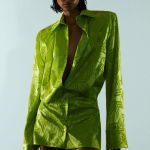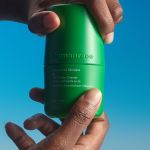
Green is the color of Gen-Z
October 22nd, 2021
If there is a color capable of representing the values and culture of the Zeta Generation it is definitely green. Immediately associated with concerns about the environmental condition, the digital evolution and the hopes of a better future after the pandemic, the green synthesizes in its brilliance the desires and hopes of the generation of those born in the late 90s and early 2000s. The theory of generational color is not abstract, because even for the Millennials, forerunners of the Gen-Z, it was the rose that distinguished the period between Mean Girls, Paris Hilton, Avril Lavigne, paparazzi, gossip and the first Apple products the reality was formed to evolve into what we know. Green is the new Millennial Pink for the Gen-Z, a dominant color in fashion, beauty and design trends that confirms with its catalyzing power the free associations that bind to both luck and money, contexts dear to kids today. But how can a color acquire cultural value to represent an entire generation? The role of green has developed over the years, thanks to fashion and to the events related to it. Let’s discover together how.
Green as SS21
Green is the color of the hottest items in the SS21 summer collections as demonstrated by the Lyst Index Q3 2021, where 4 of the most desired items in the women’s market out of 10 are green. Terry Slides by Bottega Veneta, the Nike React NXT as the Balenciaga Le Cagole Bag and La Maille Pralù by Jacquemus are the green elements included in the quarterly ranking that analyzes the behavior of over 150 million users in multichannel mode. The microtrend of green begins to appear in an acid and lime version in fashion in early 2018, as claimed by the account @thedigifairy that deals with trends and fashion on Instagram, and is worn by celebrities with a niche style a bit emo-pop of which Billie Eilish becomes the mainstream representative.
Green is then consecrated by the catwalks and avant-garde fashion of the last two years in all its shades: there are those who have made a signature, as Bottega Veneta by Daniel Lee, whose emerald green is now for all "Bottega green". Shades of grass and sage, mint and pistachio enter the range of colors of brands born on social networks such as House of Sunny and an exuberant cocktail of garments interpreting the fashion color. Desaturated versions such as forest or khaki green were the protagonists of the loungewear of the pandemic period, consecrating green almost to a new neutral color, as well as beige, in line with the fluid and unisex approach that frees itself from gender canons of recent times. The secondary color becomes both a touch of light, that pop element with which to build fashionable outfits, basic or experimental, hyper versatile and able to catalyze the attention.
Green Sustainability
For Gen-Z, climate change is a primary concern, as demonstrated by a study by Deloitte. Among student riots, demonstrations and spokesmen of exception, the environmental conditions in constant worsening are the subject of debate and growth for the youngest, who find in the green also the concretization of the values for which they often manifest. As an accomplice of the immediate mental association to environmental issues, green is used as a suffix to define business and economic practices and strategies to reduce the polluting impact, the green economy. Another theme very dear to Gen-Z is the fight against green washing, the set of operations made by multinationals, companies and companies that perform interest in the environment in communication campaigns driven by a commercial interest in attracting customers more attentive to environmental protection issues (which also has greater purchasing power).
Green Packaging and Design
The same discourse of environmental attention is translated on the packaging of products sensitive to climatic conditions, and especially in beauty the use of design as a communicator of green values seems depopulated. Brands like Human Race Skincare by Pharrell Williams, Wishful by Huda Beauty, but also Dr Jart and Drunk Elephant use green packs to recall the benefits of products with reduced environmental impact and compounds for most natural ingredients. The Sephora section "Good for..." is an excellent example to prove the growing interest of the beauty world in green issues, which often involve concrete actions to heal the oceans and the economy of troubled countries such as Davines’s Rethinking Plastic. Even in interior design the green comes in a bursting way: after seeing the calm green kitchen colouring of Dakota Johnson's house tour for Architectural Digest, the color becomes complementary to the areas where you spend a lot of time during the day and a trick to relax, thanks to its power to absorb light and to give a touch of naturalness to the environment.
A less broke, greener future?
The green resurfaces in a cathartic moment to recover the time lost during the pandemic. Representing and developing in a personal perspective for the Gen-Z as a talisman good omen for the realization of their dreams and goals, including in the financial field, The green also dresses the meaning linked to luck and hope always present in the common scenario. Despite the dubious images of the world’s future at the environmental level, the new generation will certainly be less green than the previous one: according to the Bank of America the Gen-Z will exceed the purchasing power of the Millennials through the investments of the largest companies in relaunching their proximity to a new catchment area, more interested in buying consciously and perhaps associated with a working scenario that is not merely related to the short term projects and contracts.
































































































































